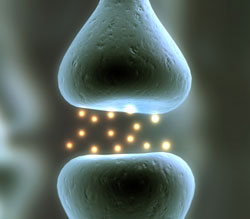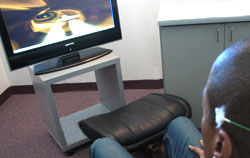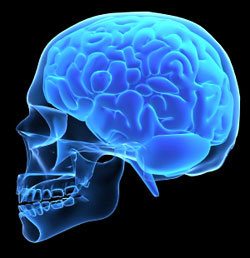Neurofeedback for Service Related Brain-Based Problems
Our Nervous System and the Ravages of War
 War places man under duress for which the nervous system is ill prepared. Over time, there may be a certain strengthening of resources, as one gets acquainted with the new demands of the war theatre. But at the same time there are likely to be increased deficits in mental functioning as well. These may be cumulative, and the effects may linger long after the warrior returns home. The increased competence that the serviceman experiences over time may mask this deterioration in functionality. But after the return home, this may be what remains, and it may increasingly loom large.
War places man under duress for which the nervous system is ill prepared. Over time, there may be a certain strengthening of resources, as one gets acquainted with the new demands of the war theatre. But at the same time there are likely to be increased deficits in mental functioning as well. These may be cumulative, and the effects may linger long after the warrior returns home. The increased competence that the serviceman experiences over time may mask this deterioration in functionality. But after the return home, this may be what remains, and it may increasingly loom large.
Such a functional decline may be difficult to admit to, but see if the story does not ring true. (And hang in there, because we have good news).
It is common to hear of difficulty with sleep. There may be difficulty falling asleep, or perhaps frequent waking, with a difficulty to fall back asleep. Sleep may not be restful, and may even be punctuated by events that seem like nightmares. If these so-called nightmares take you back to known events in the war zone, they are really flashbacks, not nightmares at all. Only these flashbacks happen to occur at night.
There may be problems with stability of mood - sudden flare-ups of anger.
There may be a generally greater level of irritability than before.
There may be swings of anxiety and depression.
There may be problems with memory, and cognitive functioning may require more efforting.
Things that you may have known about yourself from before the war are now there in spades: Attention problems; learning difficulties; short-term memory problems; relationship issues. If there were tics before, these may be worse. If there was a smoking habit before, it is now even more entrenched. And if there was a problem with drug taking, that too may be worse. If you had headaches before you went off to war, these may now be much worse, or more frequent. There may be other kinds of pain that were not there before, or they are simply worse now than before.
There may also be differences in how you relate to others. Your loved ones may be aware that you are now more remote, less accessible, less warm. Or things go in the other direction, where you become much more emotional than you used to be. Your emotions might also swing from one end of the pendulum to the other, and you may not feel in control at either end.
And Now for the Good News:
All of the above issues lie in the domain of brain function. They do not indicate, most likely, a structural problem in
the brain that we have no choice but to live with. Such a structural problem cannot be ruled out in our discussion,
obviously, but it is in fact unlikely. On the other hand, they also do not indicate a problem of the "mind," just in case
you are starting to harbor some doubts about your own sanity. And in the event that an organic brain problem exists,
that may be no barrier to recovery either.
 If we are dealing with a functional problem, something that we might call a problem of the brain's "operating system,"
then that should be the target of therapy directly. So what is the remedy? It is brain training. As we have learned
over the past few decades, the brain is amazingly plastic. This means that function is frequently largely recoverable.
A lot of this recovery will in fact occur even if you do nothing at all except go on with your life. But it might take an
awfully long time. What a waste that would be.
If we are dealing with a functional problem, something that we might call a problem of the brain's "operating system,"
then that should be the target of therapy directly. So what is the remedy? It is brain training. As we have learned
over the past few decades, the brain is amazingly plastic. This means that function is frequently largely recoverable.
A lot of this recovery will in fact occur even if you do nothing at all except go on with your life. But it might take an
awfully long time. What a waste that would be.
Let Us Illustrate:
We worked with a veteran of WWII who had not slept well since the war. In just a few training sessions, his sleep
was back to what it had been when he was a teenager in the forties. The capacity of recovery was never lost in his
brain. His functional recovery was substantial and comprehensive, covering many symptoms. It did take a lot of
training sessions in this case (68), because after half a century this man's brain had a lot of entrenched bad habits.
But the training was clearly worth it.
The brain training that we are talking about is now called neurofeedback. It used to be called EEG biofeedback. We changed it for two reasons. The first is that people tend to confuse biofeedback with things like biorhythms, and various unconventional techniques are now called biofeedback even though they don't fit the classic description. The second reason is that most people have pigeon-holed biofeedback as just relaxation training, with techniques such as hand-warming and the training of proper breathing.
Now hand-warming should not be trivialized, because a lot can be accomplished even with such a simple technique. And relaxation training should not be trivialized, either, nor should training in proper breathing. But things have gone a lot farther than that. It has all been about giving the brain better capacity to function. By now we know how to train the brain directly, and that just has a lot more relevance to the issues we are confronting. Now we look at the EEG itself, where we see the brain in the act of regulating its own behavior. And we have simply learned to recognize when the brain is going off-line or out of control. Whenever that begins to happen, we cue the brain to behave differently. We may give it a cue in the direction we would like it to go, or we may simply alert it to the fact that it is becoming disregulated. This simple procedure then allows the brain gradually to relearn good behavior.
This technique was first employed in the management of seizure disorders. Now you may not regard your own situation as being quite that serious. But you might also think that if we can take care of something as challenging as seizures, perhaps your condition can be helped as well. The technique has been further used with attention and behavior problems of children. Again, you may say that that is not relevant to your situation. But getting the brain to pay good attention to its own stuff may indeed be the issue! Most of what the brain does is worry about itself. If we can "fix" the problems of attending to the outside world, perhaps we are also attending to the problems of the inner machinery, the one that manages our moods and emotions and our readiness to function.
The technique has also been used for treating addictions. This is in fact where the story gets very close to home, because this work was first performed in a VA Hospital in Fort Lyon, CO. There a psychologist named Eugene Peniston was working for years with intractable alcoholic veterans. These were all highly functional people before Nam, and now could not stop drinking. One treatment program after another failed them. Obviously their alcoholism was a symptom of Post-Traumatic Stress Disorder (PTSD). But that term did not exist yet at the time of the Vietnam War and for years thereafter. PTSD was not described as such until the eighties.
In his first controlled study Peniston found that adding neurofeedback to the mix gave him 100% success in treatment. This was stunning, because the controls in that study, who received only the standard VA treatment program, all remained alcohol-dependent. The contrast could not have been greater, and these folks have now been sober for more than ten years (one has since succumbed to cirrhosis of the liver). Putting all the early studies together we obtained about 85% recovery in in-patient settings, about 75% in out-patient programs.
One of the criticisms leveled at Peniston after the first publication of his neurofeedback work is that he had not so much demonstrated a cure for alcoholism as that he had shown recovery from PTSD. Peniston thought, if that's the worst that could be said about his work, he would take that criticism! A remedy for PTSD in less than forty contact hours, where everything else had already failed? Not bad. In Peniston's studies, relief from PTSD symptoms and recovery from alcohol dependency was jointly observed. Of course this was not the worst judgment rendered against Peniston's work. Many still thought the results were too good to be true, and the method of achieving them entirely too unconventional.
 And now the story gets closer to home for ourselves, because in the 1994-5 time frame we launched on a program
to replicate Peniston's work in a residential treatment center here in Los Angeles. It was a four-year study, and it
took us five more years to get it published. As before, the results were simply too good to be believed. Moreover,
none of the journal editors knew of neurofeedback, I'm sure. But now this study has seen the light of day (in the
American Journal of Drug and Alcohol Abuse, Aug 2005). Our results are not too far behind Peniston: greater than
70% success, which was three times better than the controls, who received regular treatment. The study involved
121 participants. This was an even more challenging population than Peniston had worked with.
And now the story gets closer to home for ourselves, because in the 1994-5 time frame we launched on a program
to replicate Peniston's work in a residential treatment center here in Los Angeles. It was a four-year study, and it
took us five more years to get it published. As before, the results were simply too good to be believed. Moreover,
none of the journal editors knew of neurofeedback, I'm sure. But now this study has seen the light of day (in the
American Journal of Drug and Alcohol Abuse, Aug 2005). Our results are not too far behind Peniston: greater than
70% success, which was three times better than the controls, who received regular treatment. The study involved
121 participants. This was an even more challenging population than Peniston had worked with.
As documented in published research, we now know how to remediate PTSD and drug addiction, and attention problems, and mood problems, and sleep problems, and pain syndromes such as migraine. Migraine is a particular success story. Just a few years ago a study was published that demonstrated some 95% recovery from migraine using biofeedback. (This was published in the Journal of Neurotherapy in 2005. The author was psychologist Jeff Carmen). The study covered 100 subjects. This is a level of success that was previously unheard of even in the field of biofeedback. This level of success is currently being matched with EEG neurofeedback.
If neurofeedback is so wonderful, you might ask, why is it you have not heard of it? The big reason is that neurofeedback is not a drug! So it is not written about in the medical journals. Biofeedback and neurofeedback fall more into the domain of psychology. And thousands of psychologists are using biofeedback, including neurofeedback. But it is still taking a while to catch on. That's the nature of any major breakthrough in the health field. It takes time for a revolution in thinking to take hold.
The Program: GI Bill for the Brain
A large number of neurofeedback professionals have agreed to make their services available at no charge for returning veterans for mental health issues related to their service to our country. (More on this below.) You can find many of them listed in our accompanying practitioner listing. But there are many more who would respond if approached. These can be found on various lists: www.eegdirectory.com; www.isnr.org; www.bcia.org, www.aapb.org. Go to www.eegdirectory.com and enter your zip code. See who is nearby and give them a call. There are many different kinds of mental health or educational professionals active in this field, with different levels of credentialing. You need to find someone whom you are comfortable with, and who is competent to handle your issues.
In order to make this offer of free service manageable, practitioners may only accept one veteran at a time, so you may end up wait-listed for a while. Or you may end up having your sessions scheduled on a space-available basis. But the terms are attractive. You will not have to pay anything at all for what in the private-pay sphere would cost you thousands of dollars. For participants, a commitment to the training program is expected. Practitioners have nearly all had the experience that a service offered at no charge is not valued as much as one that is paid for. People may be casual about making their appointments or show up late. We therefore ask participants to do their part by following through faithfully with the training discipline.
It is very important to us as a matter of principle is that no veteran should miss out on this training opportunity for reason of lack of resources. This also means that training opportunities should be available in all areas of the country, so that there aren't any geographical barriers either. To that end, we are growing the practitioner network as rapidly as we can. Still. the numbers we have aren't sufficient to meet the need, particularly if veterans are accepted into training one at a time. If the demand for neurofeedback training grows as we expect, not all veterans can be efficiently trained on this no-cost basis. Practitioners may offer the training on favorable terms to veterans who don't wish to be wait-listed for the free service. All participating practitioners have agreed to train at least one veteran at a time at no cost to the veteran. (View minimum guidelines for practitioners in this program.) Beyond that, practitioners may differ in various ways with respect to what they are willing to offer veterans.
There's one more thing: Complementary assessments may be recommended, such as a quantitative EEG. We haven't lined up anyone yet who is willing to provide that service at no charge, so that remains a challenge for the future.
Oh, and yet one more thing: Some people benefit from training over the long term. In those cases we typically train people to do this at home, under supervision of the clinician. This would of course involve either the rental or the purchase of some instrumentation, and that understandably cannot be done without charge.
Our Role
We will serve as overall coordinator of the program, and as contact point for anyone needing additional information or particular referrals. We also run a neurofeedback clinic in Los Angeles and welcome veterans there. For more information on who we are, please visit www.eeginstitute.com
The Training Itself
 There are two aspects to this training. The first is a kind of boot camp for the brain. Neurofeedback in this instance
is a kind of close-order drill in which the brain itself is effectively the source of the commands. Go-stop; go-stop, ad
infinitum for a half hour. We reward the brain for doing the right thing; we notify it when it is doing the wrong thing.
The brain is not only the source of the information, but it is also the responding entity. You will be watching a kind of
video game that reflects the quality of brain function as we discern it. There is also auditory feedback, and possibly
tactile feedback as well. All these signals are intended to cue the brain toward better internal regulation and higher
levels of performance. This kind of training may be referred to as "SMR/beta" training, with reference to certain EEG
frequencies, or it may simply be called "eyes-open" or "awake-state" training, or "alert-state" training. Some
practitioner will employ complementary techniques such as visual or auditory stimulation. These are intended to
stimulate the brain directly at various EEG frequencies, again provoking a reaction of the brain that will eventuate in
more regular functioning over the long term. Yet other practitioners will use conventional biofeedback techniques in
combination. Some of these methods work on enhancing brain activation. This can be done either by detecting
thermal infrared emissions from the brain or by detecting blood flow activity with near-infrared measurements.
Rewarding the brain for increasing this activity often results in very quick restoration of good brain function.
There are two aspects to this training. The first is a kind of boot camp for the brain. Neurofeedback in this instance
is a kind of close-order drill in which the brain itself is effectively the source of the commands. Go-stop; go-stop, ad
infinitum for a half hour. We reward the brain for doing the right thing; we notify it when it is doing the wrong thing.
The brain is not only the source of the information, but it is also the responding entity. You will be watching a kind of
video game that reflects the quality of brain function as we discern it. There is also auditory feedback, and possibly
tactile feedback as well. All these signals are intended to cue the brain toward better internal regulation and higher
levels of performance. This kind of training may be referred to as "SMR/beta" training, with reference to certain EEG
frequencies, or it may simply be called "eyes-open" or "awake-state" training, or "alert-state" training. Some
practitioner will employ complementary techniques such as visual or auditory stimulation. These are intended to
stimulate the brain directly at various EEG frequencies, again provoking a reaction of the brain that will eventuate in
more regular functioning over the long term. Yet other practitioners will use conventional biofeedback techniques in
combination. Some of these methods work on enhancing brain activation. This can be done either by detecting
thermal infrared emissions from the brain or by detecting blood flow activity with near-infrared measurements.
Rewarding the brain for increasing this activity often results in very quick restoration of good brain function.
Testing is conventionally done ahead of time to test your vigilance and attentional skills. This tells us how to adjust the training for your brain. From that time forward, we take into account how you react to the training: alertness, pain, moods, how well you sleep, etc. Then we retest after training some twenty to forty sessions, and compare to the earlier benchmark. EEG measurements may also be made. Training is usually done in twenty-session blocks until resolution of symptoms is obtained. It is our estimate that 85% of veterans should reach their training goals in forty sessions or less. Meeting training goals means recovery of function to at least 85% of pre-war functioning. (In our greatest success story so far, a Vietnam veterans reduced his PTSD symptoms by over 90% in only eighteen sessions.) Since this is a brain-training procedure rather than merely a program of recovery, we expect that many veterans will end up functioning better than they ever have before.
The second aspect of the work addresses the more psychological aspects of the war-time experience. You may also have come away with visual memories that you wish you had never had. There may have been periods of intense fear, or of a sudden confrontation with death, or perhaps you experienced the death of members of your unit. Our bodies are geared toward registering life-threatening events in perpetuity. At the biological level, that educates the fear response. At the psychological level, we register these as traumas. In the trauma experience, these two realms become intimately coupled. When these events are re-awakened in the brain, they are often fully re-experienced. It is therefore a matter of training the brain so that these events become part of your normal memory, recallable at any time but not having you in their grip.
The second kind of training takes your brain to a benign state of inward orientation. If a traumatized individual enters such states, the traumatic memories are quite likely to surface. But they can be well managed in this state, so the body learns to accommodate these memories without upset. The entire relationship to your past will be altered. The memories are by no means erased. They just lose the power over the rest of your life. If this kind of training is indicated for you, then the first kind of training above will not be enough by itself. Most likely, some symptoms or other will just crop up again later unless the second kind of training is undertaken also, or an equivalent alternative is pursued. This second approach may be referred to variously as "deep-state" training, or "alpha-theta" training, again referring to EEG frequencies.
The Science in Brief
Let us take you through the theory very briefly. The brain has to obey all the rules imposed on any feedback control system. The brain is exceedingly well integrated in function, and that means all sorts of feedback exist which inform the brain about its own activities. Biofeedback simply represents an external feedback loop that we impose in addition.
 The brain has the challenge of operating very fast to meet its challenges, as well as to remain stable throughout.
These are conflicting goals in any control system. In wartime our brains are cued to be highly vigilant and to be
immediately responsive to any sudden input. Such a persistent stress puts enormous strain on the machinery. It also
challenges the brain's stability. If the brain is then also subjected to mild whiplash events, sub-threshold concussion
events, or experiences with traumatic content, these leave lingering effects on brain function. You may walk away
apparently unscathed at the moment, but the resources of the brain for its internal management may have been
weakened. This is not because neurons have been severed, because most likely that is not the issue at all. It need
be no more than a change in the pattern of functioning. A mere pressure wave through the brain stem can leave a
lingering change in the regulation of your sleep-wake cycle, and in your alertness and vigilance while awake.
The brain has the challenge of operating very fast to meet its challenges, as well as to remain stable throughout.
These are conflicting goals in any control system. In wartime our brains are cued to be highly vigilant and to be
immediately responsive to any sudden input. Such a persistent stress puts enormous strain on the machinery. It also
challenges the brain's stability. If the brain is then also subjected to mild whiplash events, sub-threshold concussion
events, or experiences with traumatic content, these leave lingering effects on brain function. You may walk away
apparently unscathed at the moment, but the resources of the brain for its internal management may have been
weakened. This is not because neurons have been severed, because most likely that is not the issue at all. It need
be no more than a change in the pattern of functioning. A mere pressure wave through the brain stem can leave a
lingering change in the regulation of your sleep-wake cycle, and in your alertness and vigilance while awake.
And what about those cases in which there has been real injury to the brain? We have worked with a great variety of cases of traumatic brain injury over the years. The existence of an organic locus of injury tends to focus the attention there, and also has the effect of lowering our expectations for recovery. The good news, however, is that most of the consequences of traumatic brain injury are not directly traceable to that organic injury, or to the locus of that injury. They are in fact the usual symptoms seen in many head injured folks, regardless of whether there is organic structural injury, and irrespective of where it is. These are the symptoms of head pain, first of all, plus mood disregulation, anxiety and depression, effort fatigue, energy level, vision problems, planning and executive function deficits, memory problems, motor control deficits, and problems with working memory and cognitive function. This general quality of brain injury symptoms has been known since German soldiers were studied after they came back from WWI.
These symptoms are largely the rogue's gallery already referred to as being responsive to neurofeedback. We can help here just about as well as in cases where no locus of injury has been identified. This again is due to the fact that the entirety of the neural networks involved in neuro-regulation have been altered in their function. It's not just about the place that was injured in the brain.
We see the effects of this in the EEG in most cases. The EEG will exhibit sudden changes even when you are sitting in a chair resting. That documents the brain's propensity to be unstable. And that for us represents a target for training through feedback. We also divide the EEG into its various frequencies, each of which has its own functional implications. Training some of these frequencies can be seen by analogy to putting the brain on a stair stepper. This is nothing more than an exercise. We push the brain (through feedback); it pushes back. We push it again; it pushes back again. Eventually this strengthens the brain's internal machinery of regulation.
And if all of this doesn't work? In the worst case, we will have wasted your time and some trips to the office. But if we cannot help you that will be obvious fairly early in the training. We usually expect to see some direct benefit of the training even after the first few sessions. If that is not the case, we are not inclined to stretch out the process and waste people's time. (It is prudent to issue this kind of disclaimer, since we can never know what the next case may bring. But in our experience we have been able to help every veteran to the point where they were grateful for the changes they were seeing.) The clinician may have some other alternatives to discuss with you, which you may want to consider. There are in fact quite a few different ways in which the brain can be coaxed or coached to behave better. Usually clinicians handle only one or two of these, but some have all the hardware options under one roof. Each of these options has at least one website attached to it, so you can check them all out.
Post Traumatic Stress Disorder (PTSD)
PTSD has been recognized only relatively recently. The first case so identified was in fact a Vietnam veteran who later in life got married and then was present for the delivery of his first child. Seeing the infant brought back to him the image of a disemboweled infant in the war zone. He became incoherent and had to be hospitalized. He was labeled schizophrenic and was treated as such. It was noticed by one of the more astute attending professionals that his delusions and hallucinations all referred to historical events in his life back in the war zone. They were not cut from whole cloth by his brain. They were in fact flashbacks and not the delusions of a schizophrenic at all. The poor man no doubt had the disadvantage that usually attends a crazy man trying to convince docs of his sanity, but he succeeded in time and the entire presentation of his situation changed.
And now we have a remedy that lies entirely in your own hands: Just Train Your Brain.
The Literature
The literature in this field is by now extensive. Check out www.eegresearch.com, as well as www.isnr.org and www.aapb.org. The original work by Eugene Peniston is persuasive all by itself, but all of the subsequent replications except for one support the original claims. The CRI-Help study has three-year follow-up to show that the effect of the training lasts.
Symptom Checklist (partial)
Sleep onset difficulties; frequent waking
Night terrors (unremembered; can't be awakened out of the state)
Apparent nightmares
Unrestful sleep
Seizures that were not there before
Irritability
Rages
Mood swings
Emotional numbing and withdrawal
Increased use of licit and illicit drugs
Anxiety and Depression phenomena
Worsening of symptoms of asthma, allergies, tics
Cognitive deficits
Short-term memory deficits
Slowness of thought
Heightened visual or auditory sensitivity
Racing thoughts
Blanking out; spacing out
Exaggerated Startle Response
Inability to plan activities
Increased migraine incidence; worsened migraine severity
Increased pain syndromes
Tremors; poor motor control
Dizziness or vertigo
"A Flood of Troubled Soldiers is in the Offing, Experts Predict"
"The nation's hard-pressed health care system for veterans is facing a potential deluge of tens of thousands of soldiers returning from Iraq with serious mental health problems brought on by the stress and carnage of war, veteran's advocates and military doctors say."
This sober appraisal appears in an article by Scott Shane of the New York Times. About one soldier in six is reporting anxiety, depression, or symptoms of Post-Traumatic Stress Disorder. With a total number of soldiers having served in Iraq or Afghanistan now numbering about one million, perhaps as many as 100,000 soldiers will require long-term mental health care. Close to 1000 soldiers have already had to be evacuated from the war theater because of mental status. On the other hand, post-traumatic stress disorder may not surface until months after the return from combat duty.
One platoon leader in Iraq, a Mr. Rieckoff, said that he never encountered a combat stress control unit while in Iraq. This suggests that the Armed Forces are not taking mental health concerns seriously, since much is known about how combat stress can be dealt with before the accumulation of unrelieved stress ultimately causes the soldier to burn through his resources.
Gulf War Syndrome
There is also some unfinished business left over from the earlier Gulf War, and that is Gulf War Syndrome. Neurofeedback does not constitute a cure for Gulf War Syndrome. In fact it is not a cure for anything. However, the training allows a soldier to function at a higher level given the toxic burden that may be present in his system, or given the dysfunctions that have for one reason or other accumulated since the tour of duty in Kuwait or Iraq.
 We do not have direct experience to speak to with regard to Gulf War Syndrome. However, neurofeedback has
been helpful for many who suffer from toxic chemical exposure such as hydrofluoric acid, carbon monoxide
poisoning, chlorine gas, etc. We expect that this evidence is potentially relevant to Gulf War Syndrome. The toxic
exposure or other stresses result in the disregulation of brain function, and neurofeedback can impact on that
directly - even though nothing may change with respect to any underlying organic loss that may have occurred.
We do not have direct experience to speak to with regard to Gulf War Syndrome. However, neurofeedback has
been helpful for many who suffer from toxic chemical exposure such as hydrofluoric acid, carbon monoxide
poisoning, chlorine gas, etc. We expect that this evidence is potentially relevant to Gulf War Syndrome. The toxic
exposure or other stresses result in the disregulation of brain function, and neurofeedback can impact on that
directly - even though nothing may change with respect to any underlying organic loss that may have occurred.
Minor Traumatic Brain Injury and Blast Injury
Traumatic Brain Injury is called minor when skull fracture is not involved, but this has essentially nothing to do with the severity of the deficits that may be suffered. In the following, we'll call it MTBI for short. MTBI could almost be considered a stealth disorder. It has been neglected by the field of medicine because the evidence for it has been so elusive. Over the last decade or so, functional imaging has changed that to the extent that the existence of MTBI is now acknowledged. But there aren't any remedies within standard medicine. This goes a long way to accounting for the scandal at Walter Reed Hospital. After all, the system has very little to offer the soldier with MTBI symptoms.
Neurofeedback is essentially the only available remedy for the lingering symptoms of traumatic brain injury. And it is a remedy because the deficits in TBI lie largely in the functional realm. Blast injury, concussion, or whiplash may not leave much obvious physical evidence of injury, but the loss of function may be considerable. And it may well linger over the long term. Much of this functional loss can be recovered quickly, which is to say within twenty to forty brain training sessions. Research has shown that MTBI symptom recovery by an average of 85% with respect to pre-injury levels of function within an average of about 30 training sessions. Newer methods promise even better and faster results. A trainee should know within four to six sessions that he is being significantly helped. Most likely, he will know it after only one training session.
Ongoing research is finding subtle organic injury within the brain even for blast exposure where none had been expected. The good news is that these findings helped to put blast injury on the agenda as a problem that needed to be acknowledged. Perversely, however, it also increased skepticism as to the remedies that might be brought to bear. The answer, however, is already in hand: it is neurofeedback. Good brain function is possible even in the face of distributed small-scale lesions within the brain. And even if brain function cannot be fully recovered, successful brain training for a good quality of life is still in prospect.
Home Use Systems
A variety of home use training options are becoming available for the soldier to train at home between visits to the office. This training may continue for some period to time even after the soldier has completed his in-office sessions. A certain amount of home practice over the longer term will likely lead to even greater functional recovery. If these items are to be retained over the long term, they will need to be paid for, obviously. The clinicians are only offering to donate their time.
Many of the self-regulation skills that the veteran will learn during this training will be useful over the rest of life. Eventually all this will be taught to every school child. But first things first.
Our Final Message
Our essential message to the veteran is: "Do not accept the diminishing or loss of your mental functions!" Your brain's recovery capacity is greater than even your physical recovery capacity. We know how to set you on a fast path to your recovery, but ultimately you hold the keys to unlock your brain's potential.
- Siegfried Othmer, Ph.D.
Chief Scientist, The EEG Institute and President, Homecoming for Veterans
For more information on Siegfried Othmer please visit www.drothmer.com